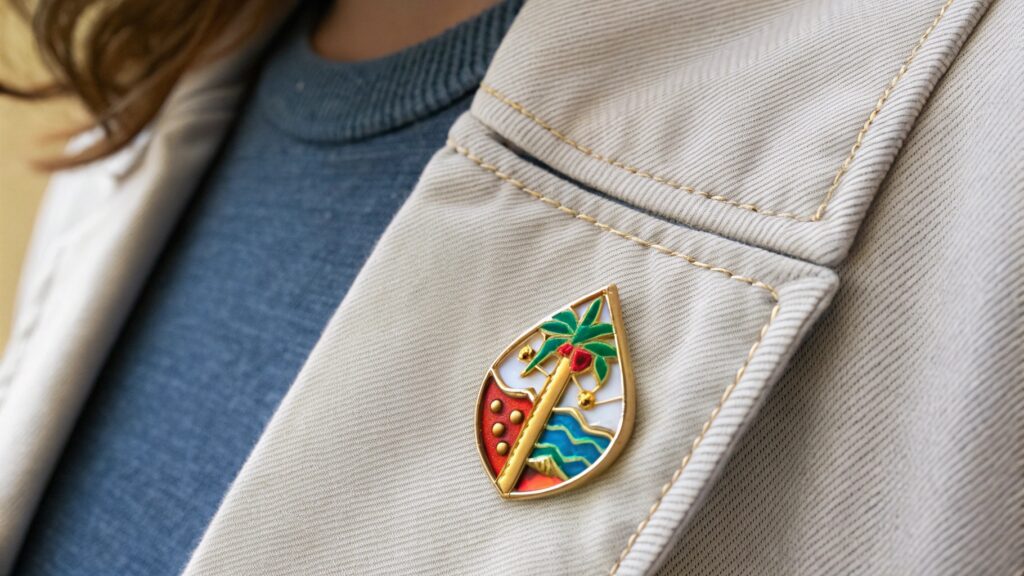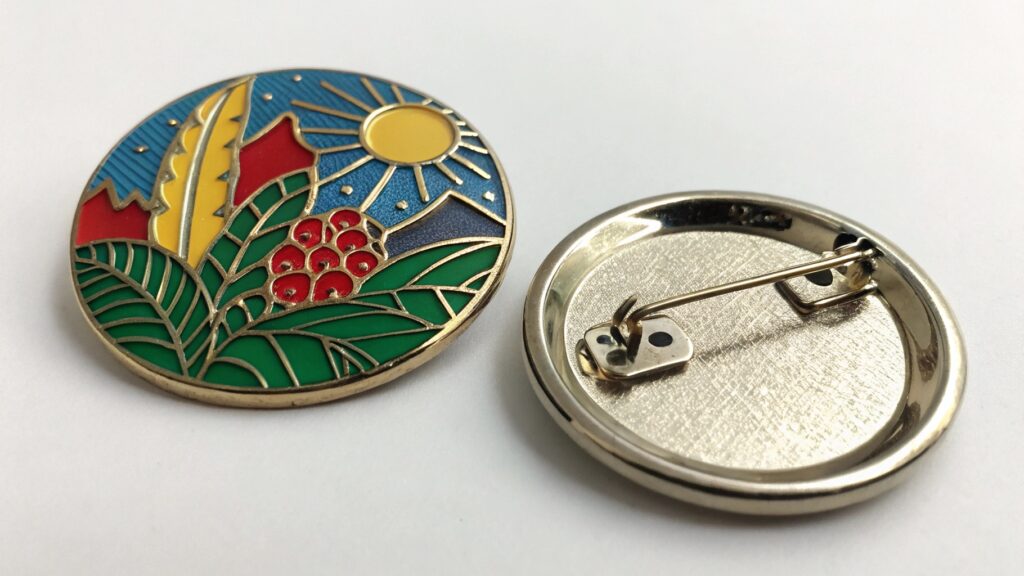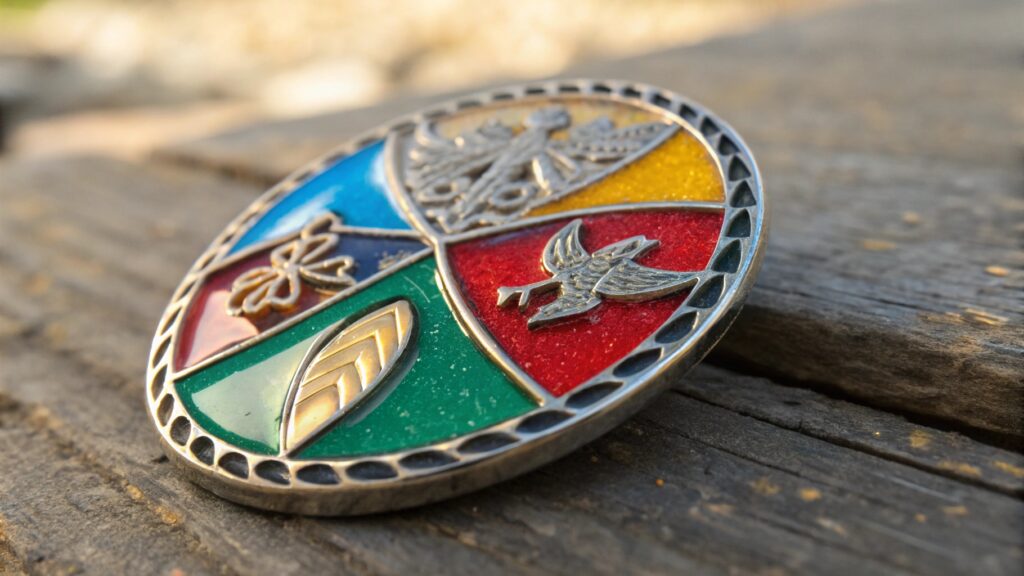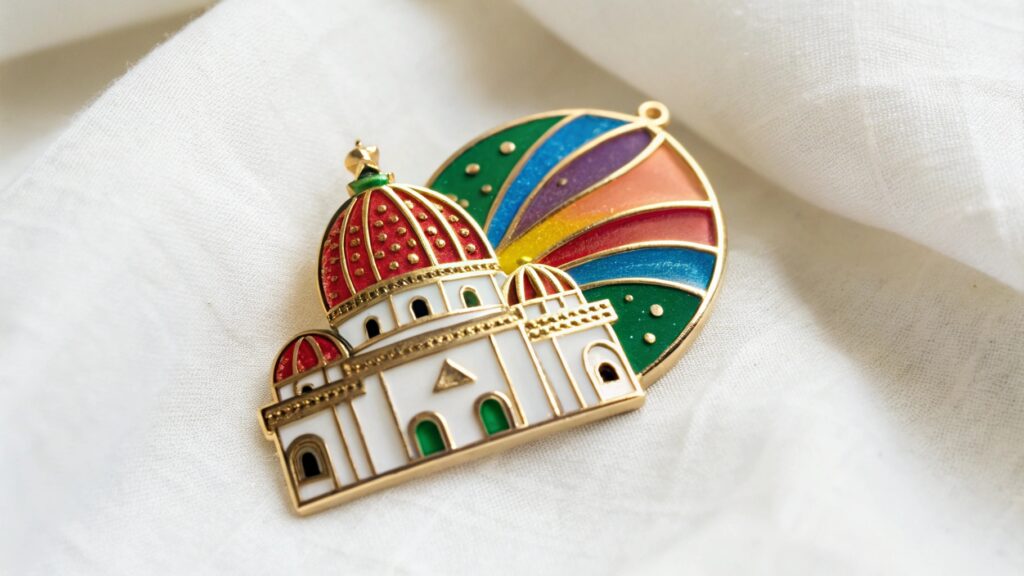What is an Enamel Badge?
Have you ever seen a small, colorful pin on someone's jacket and wondered what it is? An enamel badge is much more than just a decoration.
An enamel badge is a small, strong pin. It is made by putting colored enamel onto a metal base. Then, it is heated to create a smooth, shiny surface. These badges often tell a story or show what someone supports.

An enamel badge is a timeless way to show identity. It tells a story and can have a subtle influence. At its heart, it is a small, lasting pin. We make it by putting colored enamel onto a metal base. Then, we heat it. This makes a smooth, glossy finish. Its real value is how it puts meaning, pride, and symbols into something you can wear. Brands, groups, or people use them. Enamel badges are physical signs of belonging. This makes them culturally important in a way few other promotional items can. For me, in corporate gifting, I see how these small items build brand connection.
What is the Difference Between a Badge and an Enamel Pin?
Have you ever heard the terms "badge" and "enamel pin" and wondered if they are the same thing? It is a common question, and there are some subtle differences.
While often used interchangeably, "badge" is a broader term for any distinguishing mark or emblem. An "enamel pin" is a specific type of badge that uses enamel as its main decorative element, typically with a pin backing.

The terms "badge" and "enamel pin" are often used as if they mean the same thing. But there is a small difference. A "badge" is a general word. It refers to any item that shows who you are, what you belong to, or what you have achieved. This can be a police badge, a scout badge, or a name tag. An "enamel pin," however, is a specific kind of badge. Its main feature is that it uses enamel for color and design. It also almost always has a pin backing so you can wear it. This makes it a subset of badges. So, while all enamel pins are badges, not all badges are enamel pins. For my clients looking for corporate gifts, understanding this helps us pick the right item. We want the gift to truly represent their brand.
How Different Badges Serve Different Purposes
Different types of badges exist for various reasons. For example, a "button badge" is a simpler, usually cheaper, type made by pressing a design onto a metal base with a clear plastic cover. These are great for quick, large-scale events or campaigns. On the other hand, an "enamel pin" uses a more detailed and durable process. The enamel adds a sense of quality and permanence. This makes enamel pins popular for collectors or for brands wanting to convey a premium image. My experience in design has shown me that the choice of badge reflects the message. For Jacky, who seeks high-quality and well-designed promotional gifts, an enamel pin would often be a better fit than a simple button badge.
Materiality and Perceived Value
The materials used directly affect how valuable a badge feels. A button badge might be lightweight and feel temporary. An enamel pin, with its solid metal base and glossy enamel, feels heavier and more substantial. This tactile quality is important. It affects how people see your brand. A well-made enamel pin1 suggests attention to detail and quality. This aligns with what Jacky values for his company's brand image. When I consult with clients, I always emphasize this. A gift is not just an item; it is a representation of the brand. The perceived value of an enamel pin helps elevate that image. This is why businesses invest in them.
What are Enamel Badges Made Of?
Are you curious about the materials that give enamel badges their vibrant colors and lasting quality? It is a fascinating mix of metal and glass-like substances.
Enamel badges are mainly made of a metal base, usually brass, iron, or zinc alloy, and colored enamel. The enamel is a glass-like powder that melts when heated, creating the vibrant, durable finish.

Enamel badges are mostly made of two main parts: a metal base and colored enamel. The metal base provides the structure and shape. Common metals used are brass, iron, or zinc alloy. These metals are chosen for their strength and how well they hold detail. The colored enamel is a special type of glass powder. We apply this powder to the metal. Then, we heat the badge to a very high temperature. The heat melts the enamel powder, and it fuses to the metal. As it cools, it hardens into a smooth, shiny, and durable surface. This process is what gives enamel badges their vibrant colors and their lasting quality. Understanding these materials helps us choose the right type of badge2 for a specific brand message. My background in printing and production has given me a deep appreciation for material science.
The Two Main Types of Enamel: Hard and Soft
There are two main types of enamel used in badges: hard enamel and soft enamel. Each type has its own look and feel. Hard enamel badges have a smooth, flat surface. The enamel is polished down to be level with the metal lines. This creates a very durable and high-quality finish. Soft enamel badges have raised metal lines and recessed enamel areas. This gives them a textured, more tactile feel. The enamel sits below the metal lines. The choice between hard and soft enamel depends on the desired look and the budget. Hard enamel is usually more expensive because of the extra polishing steps. Soft enamel allows for more detail and different textures. I often guide clients through this choice to match their brand's aesthetic.
The Manufacturing Process: A Step-by-Step Look
Making an enamel badge involves several steps. First, the design is created and converted into a mold. This mold is then used to stamp the metal base, creating the outline of the design. Next, the metal is polished and plated, often with gold, silver, or black nickel. Then, the colored enamel is carefully applied by hand into the recessed areas of the design. For hard enamel, the badge is heated multiple times, and the enamel is polished flush with the metal. For soft enamel, it is heated once, and a clear epoxy coating might be added for protection. Finally, the pin backing is attached. This detailed process ensures each badge is a unique piece of craftsmanship. This is why they are often cherished items.
Do Enamel Pins Rust?
It is a common concern when considering durable promotional items: do enamel pins rust over time? Understanding the materials helps answer this.
Enamel pins are designed to be durable, but their metal components can rust if exposed to moisture or harsh conditions for long periods. The quality of the metal and plating significantly impacts their resistance to rust.

Enamel pins are made to last. However, their metal parts can rust. Rust happens when iron or steel reacts with oxygen and water. Most enamel pins use metals like brass, iron, or zinc alloy for their base. Iron-based pins are more likely to rust if not protected. To prevent rust, pins are usually plated with other metals. Common platings include gold, silver, black nickel, or copper. This plating creates a barrier. It protects the base metal from moisture and air. If the plating gets scratched or wears away, the exposed base metal can start to rust, especially in humid environments. Proper care, like keeping pins dry, helps them last longer. When sourcing gifts, I always consider the durability of the materials. Jacky, my typical client, values quality and longevity in his promotional items.
Factors Affecting Rust and Longevity
Several factors influence whether an enamel pin will rust. The type of base metal is key. Iron is very prone to rust. Brass and zinc alloy are more resistant but can still tarnish or corrode. The quality and thickness of the metal plating are also important. A thick, even plating provides better protection. Poor quality plating can wear off quickly, leaving the base metal exposed. Environmental conditions also play a big role. Pins stored in high humidity or frequently exposed to water (like on a backpack in the rain) are more likely to show signs of rust or corrosion. Saltwater is especially damaging. Proper storage and occasional cleaning can greatly extend the life of an enamel pin.
How to Care for Your Enamel Pins
To keep your enamel pins from rusting, there are a few simple care tips. First, try to keep them dry. If they get wet, dry them quickly and thoroughly. Second, store them in a cool, dry place. Avoid leaving them in humid areas like bathrooms. Third, if you need to clean them, use a soft, dry cloth. Avoid harsh chemicals or abrasive materials, which can damage the enamel or plating. For Jacky, who needs his corporate gifts to look good and last, advising on care is part of providing a full service. A well-maintained pin continues to tell its brand story for years. It reflects positively on the brand's attention to detail and quality.
Conclusion
An enamel badge is a durable pin, made of metal and colored enamel, acting as a small, wearable story. It is a symbol of identity and belonging, merging design and lasting meaning.





